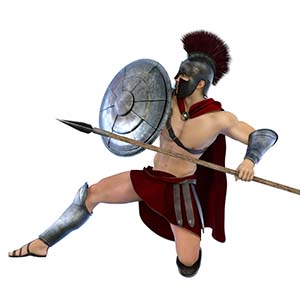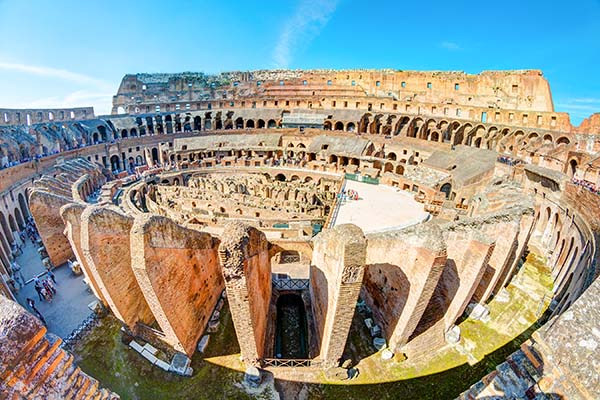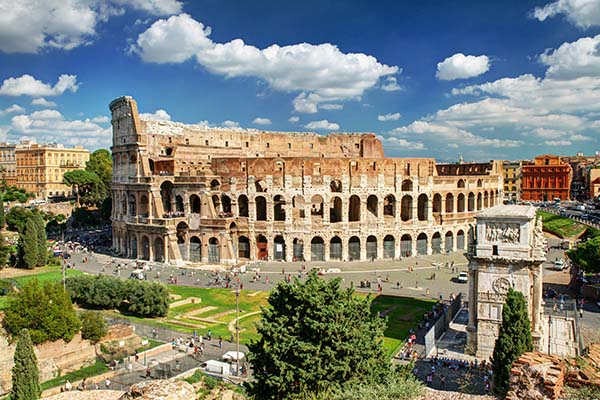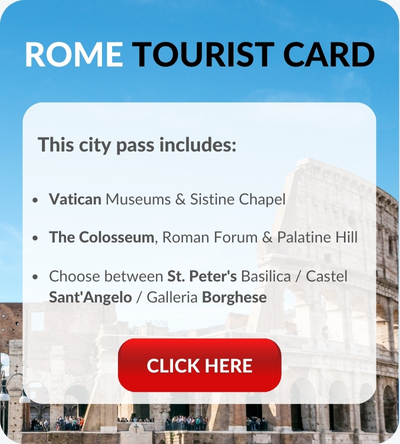
Colosseum Rome Tickets & Tours
Book your visit of the Colosseum (Coliseum), Rome's amphitheatre

All tickets and info on visiting the Coliseum in Rome Italy, the large Flavian amphitheatre from Roman times (built in the year 72 CE). Prepare your visit with the following tips and Colosseum tickets and tours.
Visiting the Colosseum - Tickets & Tours |
|
| Address | Piazza del Colosseo Rome, Italy |
| Metro | Metro stop Colosseo (line B) |
| Tickets | 📌 Attention! Tickets for the Colosseum are almost exclusively sold online. The chance of getting tickets at the box office is small. Therefore always book your tickets online. Compare the offers of different Colosseum tickets very carefully, because availability and prices can vary enormously:
📌 Best deal: The Rome City Pass is the perfect city pass with all tickets you need for your Rome city break (including Colosseum, Forum Romanum and Vatican Museums with Sistine Chapel). This card will save you money and time (more info Rome City Pass). 1. Book Tickets Only 2. Rome City Pass Guided toursWould you like a guided tour? Then choose from one of the tours below:
|
| Hours |
|
History of the Colosseum
 Flavian emperor Vespasian had this amphitheatre that could accommodate 65,000 spectators built in the year 72 CE. Construction of the Colosseum took eight years and was financed with plunder taken from Jerusalem. The Colosseum, also called the Amphitheatrum Flavium, was opened by emperor Titus with games and festivities that lasted 100 days and cost the lives of 5,000 animals. Emperor Domitian, Titus' successor, later expanded the amphitheatre with an extra storey and a number of spaces underneath the Colosseum. This made the Colosseum of Rome the largest amphitheatre in Roman history, and it is considered one of the seven wonders of the world.
Flavian emperor Vespasian had this amphitheatre that could accommodate 65,000 spectators built in the year 72 CE. Construction of the Colosseum took eight years and was financed with plunder taken from Jerusalem. The Colosseum, also called the Amphitheatrum Flavium, was opened by emperor Titus with games and festivities that lasted 100 days and cost the lives of 5,000 animals. Emperor Domitian, Titus' successor, later expanded the amphitheatre with an extra storey and a number of spaces underneath the Colosseum. This made the Colosseum of Rome the largest amphitheatre in Roman history, and it is considered one of the seven wonders of the world.
Rome's amphitheatre
The main purpose of the Colosseum in Rome was to entertain the people – and thereby increase the popularity of the emperor – with gladiator battles, sometimes including wild animals, such as elephants and tigers. It was common for animal fights to be held in the mornings by the ‘bestiarii’. During intermissions, convicted criminals were often thrown to the wild animals. Gladiator battles were held in the afternoons. As Christianity become more important, the barbaric games were finally forbidden by emperor Honorius in 404 CE. The public lynching of a monk who tried to end a fight between two gladiators was the final straw. Until the year 523, only shows with wild animals were held there.
 The arena of the Flavian amphitheater in Rome
The arena of the Flavian amphitheater in Rome Photos Colosseum Rome Italy
Photos Colosseum Rome ItalyDuring the middle ages, various earthquakes destroyed much of the Colosseum. In later centuries the ruins were stripped by popes and others to reuse the stones as building material for churches and palaces. An end was put to this plundering under Pope Benedict XIV in 1749. He considered the Colosseum Rome to be holy ground because of its important history; the blood of many Christian martyrs has been spilled there.
Facts 'Il Colosseo'
The amphitheatre could be accessed via 80 entrance arches, and the name ‘Colosseum’ (or Coliseum) was based on the colossal statue of Emperor Nero (Colossus of Nero) that stood next to the amphitheatre in those days. The total circumference of the amphitheatre is 527 metres, and it reaches a maximum height of 48.50 metres. For building materials they used limestone (1st row of arches), lighter bricks (2nd and 3rd row of arches) and concrete. The outside was finished with travertine from the hills near Tivoli. Marble was used for the seats and to clad the inner walls. The actual arena where the battles took place measured 76 by 44 metres and was surrounded by a four-metre wall. It is estimated that 300,000 to 500,000 people lost their lives in the Colosseum arena!
The stands of the amphitheatre were divided into four galleries. The seats closest to the arena were reserved for the senators, magistrates, and other important people. The emperor even had his own box with a private entrance. The second and third gallery were for male spectators, with the higher classes sitting closer to the arena. The upper, fourth gallery was for the wives of senators and knights. In those days, the Colosseum could be covered with a large, cloth awning, the so-called Velarium. According to legend, it took a thousand sailors to tighten the awning across 240 masts.
 Visit the Colosseum in Rome
Visit the Colosseum in Rome During the reign of emperor Domitian, the Colosseum's expansions included a hypogeum. This was an underground labyrinth with several trapdoors and lifts, for instance to carry large animals up into the arena. It also contained the gladiators' barracks, wild animal cages and there was an underground passageway to the largest gladiator school in Rome.
Would you like to visit the Colosseum?
For a relaxed visit to the Colosseum Rome, we strongly recommend reserving Colosseum tickets in advance. Unfortunately, long queues at the regular ticket window are very common. This combined ticket also gives you access to the Forum Romanum and the Palatine. This combined ticket is valid for one day and a must-have for anyone visiting Rome.
Virtual reality video: The Coliseum in the past
Where is the Colosseum in Rome Italy?
The Colosseum is located in the center of Rome Italy, east of the Forum Romanum, near the Colosseo metro station (Linea B). The amphitheatre is located in the Rione Monti district, in Piazza del Colosseo. It is easily accessible by public transport or on foot from different parts of the city.
FAQ Visit the Roman Amphitheater
Do I have to buy tickets for the Colosseum?
You can view the outside of the Colosseum for free, but to see the inside of the Colosseum you need tickets. Please note that the Colosseum can have long queues in high season, so it is recommended to book Coliseum tickets in advance for your desired time slot. You can easily book tickets online.
What is the entrance fee for the Colosseum?
Tickets (Combined ticket includes the Forum Romanum and Palatine as well) can be booked online starting from € 22.90
Where can I book a guided tour?
Read more about booking guided tours at this page. It's even possible to do an underground tour of the amphitheater.
Where is the Colosseum in Rome?
The Colosseum is located in the Piazza del Colosseo in Rome Italy.







